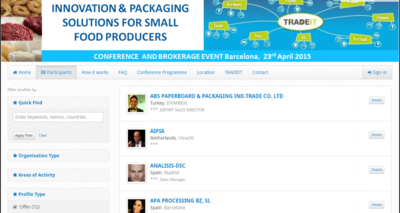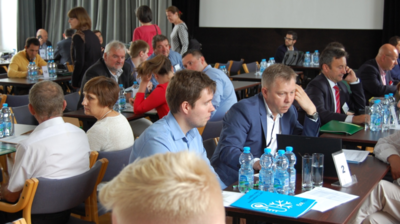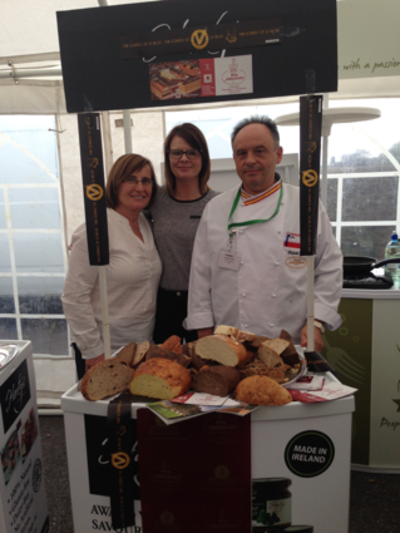Brokerage Events Review: Lessons from TRADEIT – Part II
Editor’s by-line
by Joan Lockyer
The completion of the Brokerage Events is an important TRADEIT milestone, so two newsletters focuses on the contribution to the project that these events have made so far. This newsletter is part II focussing on the TRADEIT Brokerage Events and the other five lessons learned.
The completion of the Brokerage Events is an important TRADEIT milestone, so two newsletters focuses on the contribution to the project that these events have made so far. This newsletter is part II focussing on the TRADEIT Brokerage Events and the other five lessons learned.
The act of brokerage is bringing together individuals with a common interest. This may be a problem to solve, a solution to offer or a different approach that needs to be tested or explored. The common threads have been technology and innovation. Through brokerage we have aimed to create an opportunity to link a diverse range of stakeholders (SME, technology providers, researchers and innovators) from across Europe through an event with the aim of providing unique opportunities for participants to gain insight into the value and impact of innovation support interventions in atypical sectors. Over the series of six events we have evolved a model of brokerage that provides an example of good practice for the communication of technological advances and innovation to TFP SMEs in the dairy, meat and bakery sectors. In addition to the sector specific events, we have run brokerage events that are cross-sectoral, focusing on sustainability, packaging and food safety.
These two newsletters will provide a snapshot of the highlights of each of the brokerage events undertaken throughout 2015. We have tried to draw out the main lessons learned from our experience and used them to provide a summary of 10 recommendations for planning and executing effective brokerage events. The articles spell out the detail, but here is a summary of the 10 lessons learned from TRADEIT’s events:
Lessons Part I (previous Newsletter, issue 9): - Learn from each other as well as from the experts.
- Consider the benefits of linking to a major International exhibition.
- Keep it real and keep it relevant to the audience.
- Use your networks.
- Use tours and practical demonstrations.
Lessons Part II: - Technology can make planning easier.
- Create business opportunities.
- Remember to build in some downtime for the participants to meet informally.
- Venue choice and layout are important.
- Reflection and follow-up after the event is vital.
 |
|
 |  |
|
Lesson 6: Technology Can Make Planning Easier
The primary output we need from a brokerage event is technology transfer. It doesn’t really matter how you come to it. We have already discussed the role of downtime and the opportunities presented by serendipitous networking, but it is also important to create some guaranteed meetings.
The primary output we need from a brokerage event is technology transfer. It doesn’t really matter how you come to it. We have already discussed the role of downtime and the opportunities presented by serendipitous networking, but it is also important to create some guaranteed meetings. B2Match was the package we chose to help us with that. It is the first choice of most Enterprise Europe Networks to manage their events and it offers more than just a meeting manager.
The system presents the event guest with a single place to assess the event they are considering. It allows organisers to create pages to convey information on the event theme, programme, and location; it then handles all the time consuming admin of participant registration. It will even handle multiple languages. Every participant has the opportunity to post a profile of themselves, their organisation and their needs or offers. It is searchable and participants can use the results of their searches to book meetings with people whose business or research interests them.
 The Profile Page from a TRADEIT Brokerage Event
Once the event arrives and the bookings have all been made, the B2Match system becomes the engine room of the event. It is able to take large numbers of people, with the constraints of time and space that you give it and crunch them all together producing a schedule that ensures everyone gets their meetings and discussions done in the time available. It’s a very labour saving tool. It compiles all the organisational lists you could ever need: table plans, personal schedules, full participant directories and the all-important organiser’s schedule, complete with phone numbers to help you find anyone who does not arrive on time for your meeting.

Participants in Brokerage Meetings at the TRADEIT event in Poznan
If it all sounds too good to be true it is important to recognise that things can still go wrong with the meetings. We are, after all, dealing with human beings. Over the course of six brokerage events most of the weaknesses of the organised meeting system showed themselves. People do their best to book relevant meetings, but the information they have to do it with is only as good as that supplied. Some small business owners didn’t understand the importance of the opportunities the meetings offered and provided poor profiles or didn’t book the right meetings.
As organisers we sometimes found ourselves looking worriedly at empty tables. There were many reasons – at the first meeting in Potsdam there was a train strike and some participants were unable to attend. We also found that some people had already met and had their discussion during more relaxed networking opportunities. Language could also be a problem. Although the system asks for languages spoken it doesn’t provide information whether there is a match. On a couple of occasions we were to be found scurrying around the venue in search of a translator with the required languages. The highly organised system didn’t cope well with changes to the program. When programs ran late there rigid time dependant system created confusion as we tried to reschedule around the new circumstances. Those who, through language or attentions span difficulties, had failed to keep up with the new timetable for meetings began turning up at the wrong times or not at all, creating a certain amount of dissatisfaction.
After the event we have been able to use the built in mailing system to follow up with participants for feedback and to assist with the partnerships that have been formed. This has been very useful and much more effective than trying to establish which serendipitous meetings have been useful. But as with all networking events and tools – the real proof will evolve over the years that follow.
 |  |
Lesson 7: Create Opportunities
Food Safety Brokerage Event
This brokerage event, the last in the series, addressed the very significant subject of food safety. It brought together food producers and experts in food safety from across Europe.
This brokerage event, the last in the series, addressed the very significant subject of food safety. It brought together food producers and experts in food safety from across Europe. The aim was to present technologies suitable for traditional food producers and to facilitate the exchange of best practice in this vital topic of food safety.
As with earlier brokerage events, this programme provided a combination of presentations, meetings and pitches between traditional food producers, food safety experts and food safety technology providers. The main topics on the agenda were: - Detection of Food Contamination
- Tracking, Tracing and Authentication of Foods
- Cleaning and Disinfection
- Novel Technologies for Safe Food Processing
On Day 2, participants visited local food companies and had the opportunity to engage in further networking. Bi-lateral meetings took place organised around specific food safety themes and people has the opportunity to book face to face meetings, both business-to-business (B2B) and business-to academia (B2A).
The event provided artisan food producers, from all sectors, with an opportunity to discuss common food safety challenges and to share best practice ideas amongst themselves and through access to experts and researchers in the subject.
What distinguished this event from other brokerage events was the timing. Arranged to coincide with the famous Dingle Food Festival, TRADEIT producers has the opportunity to participate in the EuroFoodVision marquee where they had an opportunity to showcase their products and meet with major food buyers from the Irish and UK markets who were attending the Dingle Food Festival.
The EuroFoodVision marquee was located in the heart of the festival and, although initially closed to the public to provide food producers with an opportunity to talk to buyers, it was later opened to allow Festival visitors to sample food from a range of TRADEIT affiliated producers. While not allowed to sell their products, producers could offer samples on a stall within the marquee and display their food products and marketing materials.
Several producers had detailed discussions with buyers and gained feedback on their products and approaches to the marketplace. Many more people sampled the products when the marquee was opened to the public and people continued to visit in great numbers until the close of the day.

The feedback from the public and from the buyers provided a massive confidence boost to many of the producers. Running the brokerage events to coincide with the food festival, gave the food producers the opportunity see what other food producers are doing; it gave them a chance to sample others producers products and most significantly to look for opportunities to find me markets for their own products, through access to buyers and the public in general.
 |  |
Lesson 8: Remember to build in some downtime for participants to meet informally
There’s a famous line about being too busy fighting with alligators to be able to get on with draining the swamp. It’s a problem we see TRADEIT SME clients struggling with all of the time. It’s one of the important things we are here to help with - creating opportunities to discover new technologies and enable the process of acquiring those that are relevant to you.
There’s a famous line about being too busy fighting with alligators to be able to get on with draining the swamp. It’s a problem we see TRADEIT SME clients struggling with all of the time. It’s one of the important things we are here to help with - creating opportunities to discover new technologies and enable the process of acquiring those that are relevant to you.
To achieve this, we have run a successful series of Brokerage events across Europe, bringing together food industry specialists, researchers and, most importantly, small food producers.
Brokerage events are a well proven way of ensuring that you get time with people you might struggle to find in other circumstances. Over the six events, in four different countries, 712 people took part in 627 separate meetings. These meetings have resulted in co-operations and the acquisition of technology that is already changing businesses and increasing employment.
The technologies we are transferring as a direct result of the meetings are not the only benefit. Along with the formal meetings we created many opportunities for informal networking, allowing producers from nine different countries to meet each other, exchange knowledge, problems and best practice. Language was only a temporary barrier in Potsdam, when Bakers were able to sink their arms together into dough and bake, and when meat producers gathered over Pinchos and wine in Logrono another level of understanding was achieved. TRADEIT network members were always on hand to find or provide translation where needed and a number of profitable co-operations have sprung up from the conversations that started in more relaxed surroundings.
We asked the participants what they thought of their experience after each event and below are some of the things they told us:
“I really liked meeting producers from different countries and sharing information.” Dermot, Ireland, Baker.
“The best part was the time when you get the possibility to talk afterwards with people who were giving their speeches.” Sami, Finland, Meat Producer.
“Knowing the kind of problem that Carnicas companies have was very good.” Javier, Spain, Meat Producer.
“It was a chance to take a step back and look at your work and business in different ways. It helps me to come back and contribute more when solutions are required in various aspects of the business.” JP, Ireland, Dairy.
“It was good, time to have some unexpected talks, which in any case intend to be the best ones.” Volker, Germany, Baker.
Time and again the participants told us that they got more than just the interactions from the events. For a short time they were able to step outside their businesses and reflect on the conversations they have had with their Hub Advisors. After worrying that they could not afford the time away from their business, most were quick to join the queue to attend another meeting. There are additional partnerships, co-operations and technology transfers springing up across Europe that owe little to the technological content and much to the atmosphere and conversations that we were able to inspire. Added to the directly organised co-operations they make the events very successful indeed.
So what is the first take away message from Brokerage? It’s not just about the formal exchanges and the knowledge gained from the process. We know that peers from the same industry can directly relate to the challenges and frustrations of a particular context; practitioner’s share knowledge in a way that can be as beneficial, if not more so, than most other sources of support or intervention.
 |  |
Lesson 9: Venue choice and layout are important
Over the course of the six brokerage events, we had the opportunity to try a number of brokerage models, in a range of layouts and venues. Some key lessons were learned as a consequence of this.
Over the course of the six brokerage events, we had the opportunity to try a number of brokerage models, in a range of layouts and venues. Some key lessons were learned as a consequence of this.
- If the activities are too widely distributed people don’t readily move from activity to activity. This means that you need to have a body of people tracking down participants who have arranged bi-lateral meeting (for example) and are chatting with exhibitors in another part of the building. Activities need to be arranged in a way that keeps people relatively close, without overcrowding them.
- Brokerage activities tend to be a combination of presentations, meetings (formal networking) and networking (informal meetings). Space for food needs to be made in the programme. In our experience, it’s best if you can find a venue that allows these activities to be undertaken in adjacent rooms (or in one room, if the room is big enough).
- Keeping people in one room was easiest for us when the brokerage events were held at the large conference and convention centres, they are built for this purpose. Our experience is that the benefits of running a brokerage event at an international coherence and exhibition outweigh the limitations. The limitations are 1) cost and 2) the potential for the participants to migrate to the exhibition halls for other meetings or to see the show. Keeping track of the invited audience can be tricky at these events. On the plus side, people can come along to see what is happening even when they haven’t been invited.
- There is a growing convention to the layout of rooms for bi-lateral meetings. The B2Match software that we utilised for the events was incredibly useful for scheduling and planning – down to the number of tables we needed. If space is limited, you need more time to run the bi-lateral meetings and getting the balance right can be tricky. The earlier the planning starts, the more certain you can be about the amount of space and/or time needed for formal meetings.
- People will always congregate around food and drink. If you locate these away from where the rest of the activities are, you may find it hard to get people to meetings or the visit exhibition space.
 |  |
Lesson 10: Reflection and follow-up are vital
Running a series of brokerage events in relatively quick succession sometimes made it difficult to stop and reflect on what had worked well and what hadn’t worked as well as expected.
Running a series of brokerage events in relatively quick succession sometimes made it difficult to stop and reflect on what had worked well and what hadn’t worked as well as expected.
Some of the issues covered in the lessons above are cases in point, such as: - Was the room layout right?
- Did we have too many technical speakers?
- Can we fit in practical sessions?
- Are the SME and technology providers well matched?
- Are the days too long?
- ...and so on.
The aim of trying to document our experiences as 10 lessons is partly because we did learn as we went along and we did make some mistakes along the way.
In planning for a large event, all efforts go into the preparation and little thought is given to the aftermath and follow-up. While feedback from participants is generally gained on the day, what B2Match gave us the chance to do is to get more reflective follow-up after the event to make sure that we captured the considered views of our participants and speakers, not just the ‘happy sheet’ feedback when only captures limited (but important) feedback from the moment.
Our aim has been to follow-up with not just the participant SMEs, but the speakers and the exhibitors to see what follow-up action they took or received from others after the event. This exercise is still ongoing as it can be sometime after the event that links and connections are made.
Our last lesson is that follow-up and reflection are as vital a part of the process after the event as planning and preparation are before it.
 |
|
|
|